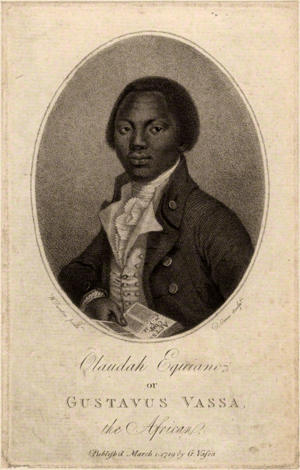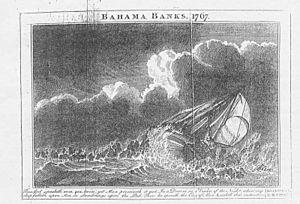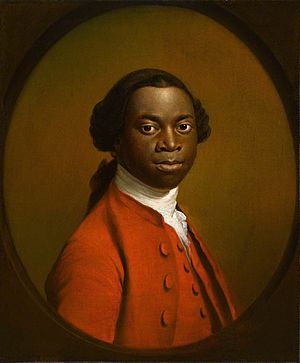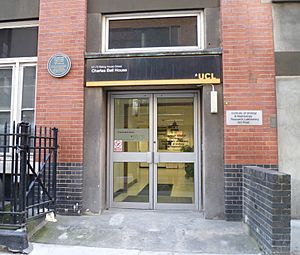Olaudah Equiano facts for kids
Quick facts for kids
Olaudah Equiano
|
|
|---|---|

Equiano by Daniel Orme, frontispiece of his autobiography (1789)
|
|
| Born | c. 1745 |
| Died | 31 March 1797 (aged 52) |
| Other names | Gustavus Vassa, Jacob, Michael |
| Occupation |
|
| Known for | Influence over British abolitionists; The Interesting Narrative of the Life of Olaudah Equiano |
| Spouse(s) |
Susannah Cullen
(m. 1792; |
| Children | Anna Maria Vassa Joanna Vassa |
Olaudah Equiano (around 1745 – 31 March 1797) was a famous writer and abolitionist. He was known for most of his life as Gustavus Vassa. Equiano was born in the Eboe (Igbo) region of the Kingdom of Benin, which is now southern Nigeria.
When he was a child, he was kidnapped and forced into slavery. He was taken across the Atlantic Ocean to the Caribbean. There, he was sold to a Royal Navy officer. He was sold two more times, but he managed to buy his freedom in 1766.
After becoming free, Equiano lived in London. He strongly supported the movement to end slavery in Britain. He was part of the Sons of Africa, a group of Africans living in Britain who fought against slavery.
In 1789, Equiano published his autobiography, The Interesting Narrative of the Life of Olaudah Equiano. This book showed the terrible realities of slavery. It became very popular and helped lead to the British Slave Trade Act 1807. This law made the slave trade illegal. Equiano married Susannah Cullen in 1792, and they had two daughters. He passed away in 1797 in Westminster.
Since the late 1900s, his autobiography has been studied by many experts.
Contents
Early Life and Enslavement
Equiano wrote in his book that he was born in a village called Essaka. This village was in the Eboe region of the Kingdom of Benin around 1745. This area is now in the southeast part of Nigeria.
When he was about eleven years old, he and his sister were left alone at home. This was common when adults went out to work. They were both kidnapped and taken far from their village. They were separated and sold to slave traders. Equiano tried to escape but could not.
He was sold several times. Once, he even met his sister again, but they were soon separated. About six or seven months after he was kidnapped, he reached the coast. There, he was forced onto a European slave ship. He was transported with 244 other enslaved Africans across the Atlantic Ocean. They went to Barbados in the British West Indies. Equiano and a few others were then sent to be sold in the Colony of Virginia.
Some scholars believe Equiano might have been born in colonial South Carolina. This idea comes from a baptism record from 1759 and a ship's record from 1773. However, many other experts disagree. They believe Equiano's own story about being born in Africa is true.
In Virginia, Equiano was bought by Michael Henry Pascal. Pascal was a lieutenant in the Royal Navy. Pascal gave him a new name, "Gustavus Vassa." This name came from a 16th-century King of Sweden named Gustav Vasa. Equiano had already been renamed twice before. He was called Michael on the slave ship and Jacob by his first owner. Equiano did not want the new name, Gustavus. He said this "gained me many a cuff" (meaning he was hit). He eventually accepted the name. He used Gustavus Vassa for the rest of his life in official records. He only used "Olaudah Equiano" in his autobiography.
Pascal took Equiano with him to England. Equiano worked as his personal helper during the Seven Years' War (1756–1763) against France. Equiano saw important battles like the Siege of Louisbourg (1758) and the Battle of Lagos (1759). He was also trained as a sailor. His job was to carry gunpowder to the ship's cannons during battles. Pascal liked Equiano and sent him to his sister-in-law in Great Britain. There, Equiano went to school and learned to read and write.
Equiano became a Christian and was baptised on 9 February 1759. This happened at St Margaret's, Westminster. The church record said he was "a Black, born in Carolina, 12 years old." His godparents were Mary and Maynard Guerin. They were cousins of his owner, Pascal. They helped him learn English. Later, they confirmed that Equiano spoke very little English when he first arrived in London.
In December 1762, Pascal sold Equiano to Captain James Doran. This happened on the ship Charming Sally at Gravesend. Equiano was taken back to the Caribbean, to Montserrat. There, he was sold to Robert King. King was a Quaker merchant from Philadelphia. He traded goods in the Caribbean.
Gaining Freedom

Robert King made Equiano work on his ships and in his shops. In 1765, when Equiano was about 20, King made him a promise. He said Equiano could buy his freedom for 40 pounds. King helped Equiano learn to read and write even better. He also guided him in his religious faith. King allowed Equiano to trade goods for himself, as well as for King. Equiano sold fruits, glass cups, and other items between Georgia and the Caribbean islands.
King kept his promise, and Equiano bought his freedom in 1766. King asked Equiano to stay and be his business partner. However, Equiano felt it was too dangerous to remain in the British colonies as a freedman. Once, while loading a ship in Georgia, he was almost kidnapped back into slavery.
Life as a Free Man
Around 1768, Equiano moved to Britain. He continued to work at sea, often as a deckhand based in England. In 1773, he sailed to the Arctic on the Royal Navy ship HMS Racehorse. This was part of an expedition to the North Pole. On this trip, he worked with Dr Charles Irving. Irving had found a way to make fresh water from seawater.
Two years later, Irving hired Equiano for a project in Central America. This was on the Mosquito Coast. Equiano was to use his African background to help choose and manage enslaved workers on sugar-cane farms. Irving and Equiano worked together and were friends for over ten years. However, the sugar farm project failed. Equiano also met George, the son of the "Musquito king."
Equiano left the Mosquito Coast in 1776. He arrived back in Plymouth, England, on 7 January 1777.
A Leader in the Fight Against Slavery
Equiano settled in London. In the 1780s, he became very involved in the movement to end slavery. This movement was strong among Quakers. In 1787, the Society for Effecting the Abolition of the Slave Trade was formed. This group included members from different churches, including Anglicans. They wanted to directly influence the British Parliament. Equiano was inspired by the Christian preacher George Whitefield.
As early as 1783, Equiano shared information about the slave trade with abolitionists like Granville Sharp. That year, he was the first to tell Sharp about the terrible Zong massacre. This event was being discussed in London because of insurance claims. It became a very important case for the abolitionist movement and helped it grow.
On 21 October 1785, Equiano was one of eight African delegates from America. They presented a thank-you message to the Quakers at a meeting in London.
Abolitionists became friends with Equiano and supported him. Many encouraged him to write and publish his life story. He received financial help from people who supported the anti-slavery cause and from religious groups. His lectures and book preparation were promoted by people like Selina Hastings, Countess of Huntingdon.
His Famous Book
Equiano's book was called The Interesting Narrative of the Life of Olaudah Equiano, or Gustavus Vassa, the African. It was published in 1789. The book was so popular that it had nine editions during his lifetime. It is one of the first well-known books written by an African author to be widely read in England. By 1792, it was a bestseller and had been published in Russia, Germany, Holland, and the United States. It was the first important slave narrative, which became a big type of literature.
Equiano's experience as an enslaved person was different from most. He did not work in fields. He served his owners personally and traveled by sea. He was taught to read and write and worked in trading.
His personal story of slavery, his journey to freedom, and his experiences as a black immigrant caused a stir when the book came out. The book helped grow the anti-slavery movement in Great Britain, Europe, and the New World. Many people were surprised by how well he wrote and described things.
In his book, Equiano shared details about his hometown and the customs of the Eboe people. After being captured as a boy, he described the communities he passed through as a captive. His book also tells about his journey on a slave ship. He wrote about the harshness of slavery in the West Indies, Virginia, and Georgia.
Equiano also wrote about the limited rights that free people of color had in these places. They also risked being kidnapped and forced back into slavery. Equiano became a Christian at age 14. His faith was a very important part of his life and his book. He was baptised into the Church of England in 1759. He called himself a "protestant of the church of England" but also explored Methodism.
Some events made Equiano question his faith. In 1774, he was upset when his friend, a black cook named John Annis, was kidnapped. Annis was taken from the British ship Anglicania. His kidnapper, William Kirkpatrick, ignored a court decision from 1772. This decision said that enslaved people could not be taken from England without their permission. Kirkpatrick sent Annis to Saint Kitts. There, Annis was badly treated and worked on a farm until he died. Equiano tried to get Annis released with the help of Granville Sharp, but he failed.
Despite his questions, Equiano always kept his Christian faith. His book ends with a quote from the prophet Micah (Micah 6:8): "After all, what makes any event important, unless by its observation we become better and wiser, and learn 'to do justly, to love mercy, and to walk humbly before God?'"
In his book, Equiano also wrote about settling in London. He married an English woman and lived with her in Soham, Cambridgeshire. They had two daughters. He became a leading abolitionist in the 1780s. He gave talks in many cities against the slave trade. Equiano recorded his and Granville Sharp's important roles in the anti-slave trade movement. They worked to make the Zong massacre known in 1783.
People who reviewed his book found that it showed the full humanity of Africans. It also showed how cruel slavery was. The book was seen as an excellent work of English literature by a new African author. Equiano sold so many copies that he became financially independent. He traveled across England, Scotland, and Ireland to promote his book. He also worked to improve life in Africa. He became involved in Sierra Leone. This was a colony founded in 1792 by Britain for freed slaves in West Africa.
Later Years and Family
During the American Revolutionary War, Britain offered freedom to enslaved people who fought with them. This led thousands of enslaved people to join the British side. When the war ended, British officers helped these former American slaves leave. They were settled in the Caribbean, Nova Scotia, Sierra Leone, and London.
In 1783, after the United States became independent, Equiano helped the Black Poor of London. These were mostly former African-American slaves freed by the British during the war. There were also some freed slaves from the Caribbean. Some had been brought to England by their owners and later freed. The black community in London was about 20,000 people. Many of these freed people found it hard to start new lives in London or Canada.
In November 1786, Equiano was made "Commissary of Provisions and Stores for the Black Poor going to Sierra Leone." This was a trip to resettle London's Black Poor in Freetown. Freetown was a new British colony on the west coast of Africa, in present-day Sierra Leone. More than 1,200 Black Loyalists from Nova Scotia joined the black people from London. They were helped by John Clarkson. Equiano was later removed from this project. He had protested against money being managed badly. He then returned to London.
Equiano was an important person in London. He often spoke for the black community. He was a main member of the Sons of Africa. This was a small group of free Africans in London who fought against slavery. They worked closely with the Society for the Abolition of the Slave Trade. Equiano's opinions were published in newspapers like the Public Advertiser. He spoke out against people who supported slavery. Equiano used his public voice more than most Africans at the time.
Equiano was also active in the London Corresponding Society. This group wanted democratic changes. In 1791–92, while promoting his book, he connected this society with other groups. This included the Society of United Irishmen. In Belfast, Equiano was hosted by Samuel Neilson, a leader of the United Irishmen.
Marriage and Family Life

On 7 April 1792, Equiano married Susannah Cullen. She was a local woman from Soham, Cambridgeshire. The original marriage record is kept by the Cambridgeshire Archives and Local Studies. He added his marriage to every new edition of his book from 1792 onwards. The couple lived in the area and had two daughters. Their names were Anna Maria (1793–1797) and Joanna (1795–1857). They were baptised at Soham church.
Susannah died in February 1796, at age 34. Equiano died a year later, on 31 March 1797. Soon after, their older daughter, Anna Maria, died at age four. This left their younger daughter, Joanna Vassa, to inherit Equiano's money when she turned 21. His estate was worth about £950. Anna Maria is remembered with a plaque at St Andrew's Church, Chesterton, Cambridge. Joanna Vassa married Reverend Henry Bromley in 1821. They are both buried at the Abney Park Cemetery in Stoke Newington, London. Their monument is now a Grade II listed building.
Last Days
Equiano wrote his will on 28 May 1796. At that time, he lived at the Plaisterers' Hall in London. He later moved to John Street (now Whitfield Street). When he died on 31 March 1797, he was living in Paddington Street, Westminster. Equiano's death was reported in both American and British newspapers.
Equiano was buried on 6 April at Whitefield's Tabernacle. The burial record says "Gustus Vasa, 52 years, St Mary Le bone." His burial place is now lost. The small burial ground is now Whitfield Gardens. The chapel site is now the American International Church.
In his will, Equiano stated that if his daughters died before age 21, half of his wealth would go to the Sierra Leone Company for a school in Sierra Leone. The other half would go to the London Missionary Society.
Legacy and Influence
- The Equiano Society was started in London in 1996. Its goal is to share and celebrate the life and work of Olaudah Equiano.
- In 1789, Equiano lived at 10 Union Street (now 73 Riding House Street). A special green plaque was put there on 11 October 2000. This was part of Black History Month.
- Equiano is honored by the Church of England. He is remembered in its Calendar of saints on 30 July. This is a special day along with Thomas Clarkson and William Wilberforce, who also fought to end slavery.
- In 2007, Britain celebrated 200 years since the end of the slave trade. Equiano's life and achievements were added to the National Curriculum in schools.
- A statue of Equiano, made by students, was put up in Telegraph Hill Lower Park, London, in 2008.
- The head of Equiano is part of Martin Bond's 1997 sculpture Wall of the Ancestors in Deptford, London.
- Author Ann Cameron wrote a children's version of Equiano's autobiography. It was published in 1995 as The Kidnapped Prince: The Life of Olaudah Equiano.
- On 16 October 2017, Google Doodle honored Equiano on what would have been his 272nd birthday.
- A crater on Mercury was named "Equiano" in 1976.
- In 2019, Google Cloud named a special underwater internet cable after Equiano. It runs from Portugal along the West Coast of Africa to South Africa.
- In 2022, the city of Cambridge renamed Riverside Bridge to Equiano Bridge.
Equiano in Other Media
- The actor Louis Mahoney played Equiano in the BBC TV series The Fight Against Slavery (1975).
- A short film, Son of Africa: The Slave Narrative of Olaudah Equiano (1996), used actors and old records to tell his story.
- The musician Youssou N'Dour played Equiano in the film Amazing Grace (2006).
- African Snow (2007) is a play about Equiano and John Newton, a former slave ship captain.
- Dr Robert Hume wrote a children's book called Equiano: The Slave with the Loud Voice (2007).
- David and Jessica Oyelowo played Olaudah and his wife in a BBC 7 radio show (2007).
- The jazz artist Soweto Kinch has a song called "Equiano's Tears" (2003).
- Jeffery Kissoon played Equiano in the play An African Cargo (2007).
- Danny Sapani played Equiano in the BBC series Garrow's Law (2010).
- The Nigerian writer Chika Unigwe wrote a fictional book about Equiano called The Black Messiah (2013).
- A short animated film, The Interesting Narrative of Olaudah Equiano (2007), featured Chris Rochester as Equiano.
- A TikTok series called @equiano.stories tells Equiano's childhood story using videos and images.
- In 2022, a documentary called The Amazing Life of Olaudah Equiano was broadcast by BBC Radio 4.
See also
 In Spanish: Olaudah Equiano para niños
In Spanish: Olaudah Equiano para niños
- Nigerian aristocracy, the class that Equiano belonged to at birth
- Black British elite, the class that Equiano joined after gaining his freedom
- Ottobah Cugoano, an African abolitionist active in Britain in the late 18th century
- Phillis Wheatley, recognised in the 18th century as the first African-American poet; first African-American woman to publish a book
- List of civil rights leaders
- List of slaves


